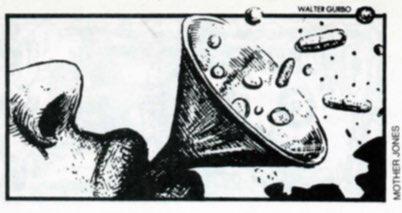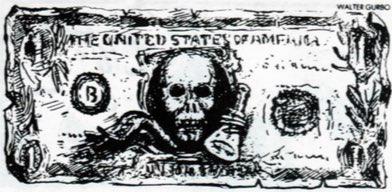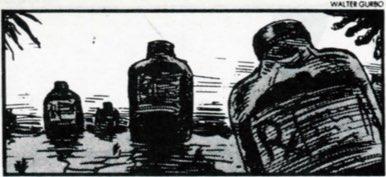Modern science has revolutionized medicine, creating everything from new wonder drugs to the miraculous feats of microsurgery. But to millions of poor consumers the world over, good health care remains a hollow promise. Instead, their needs have been ignored by health planners and exploited by the pharmaceutical industry. Health Action International (HAI), a new global citizens network, is fighting for a health care system which puts the needs of people first.
From Generating Power: A Guide to Consumer Organizing
International Organization of Consumers Unions
P.O. Box 045
Penang, Malaysia
As in many Latin American cities, the slums in Chimbote, Peru are strung along rocky hillsides or precariously balanced on the sides of steep ravines. Like others in the Third World, Chimbote's poor are plagued by the illnesses of poverty — the legacy of bad sanitation, poor hygiene and inadequate nutrition.
Diarrhoea is a common killer. Infants and young children appear daily at local clinics, weak, listless and dehydrated. Desperate mothers cling to the hope that modem medicines will bring miraculous results. In Chimbote their choice is often 'Erba', a chocolate flavoured tablet which can be bought in ones and twos in local family-run groceries and corner 'farmacias'.
These 'sweeties for diarrhoea', as the local children call them, are a runaway bestseller. But there is a catch. Like many other drugs and potions sold in the developing world, these innocent-looking brown pills may be lethal. Used mostly for children, they contain a mixture of chloramphenicol and tetracycline. Both are antibiotics. The first has a record of deadly side-effects stretching back to the 1950s, including an often fatal blood disease. The second, manufacturers in the UK advise not to be given to children under 12.
In poor countries like Peru, these warnings mean little. Literally thousands of drugs compete for space on pharmacy shelves. Some are completely useless; others are sold without the instructions or warnings which developed countries regard as essential for consumers.

A big part of the problem lies with the international pharmaceutical industry, a collection of private corporations that have become a dominant force in global health care over the last four decades. Over 90 percent of world drug production is controlled by a mere 110 companies - and ten of them control one-quarter of the total trade. Six countries (the US, the UK, Switzerland, Japan, West Germany and France) account for a full 70 percent of the world's drug production.
What does this stranglehold over an industry crucial to the health of millions mean for ordinary consumers? For one thing it means waste, lots of it. Drugs are produced not because they are effective, but often simply because they sell.
Many thousands of drugs vie for the consumer's attention. Yet, the World Health Organization (WHO) classifies only about 200 drugs as 'essential' - absolutely indispensable to a nation's health needs.
In India there are over 15,000 branded drugs on the market, in the UK more than 17,000 and in Brazil more than 20,000. A pill for every ill, and in some cases several dozen.
The resulting chaos is daunting not only for consumers but also for health professionals. In Third World countries, doctors and pharmacies often have no more to go on than the printed instructions of the drug company or the recommendations of the salesman. This is compounded by the fact that in some developing countries up to 75 percent of all medicines are sold without prescriptions. For example, one survey of Mexican pharmacies found 90 percent of them staffed by unqualified sales assistants. As a result the market is swamped with a flood of 'copy cat' drugs attempting to cash in on a competitor's success by offering virtually the same cure with a slicker package and a different brand name. The resulting competition means companies spend as much as 20 percent of gross sales income on promotion. Inevitably, consumers must pay the bill in the final market price of the drug.
The pressure to remain competitive leads companies to take advantage of weak drug legislation whenever they can and even to hush up medical evidence of hazardous products in extreme cases. Chloramphenicol, the drug contained in the chocolate-flavoured diarrhoea pills from Peru, is a classic example.
Developed by the US multinational Parke-Davis in 1949, the drug was linked to aplastic anaemia (a severe and often fatal blood disease) in the early 1950s. As a result its use was heavily restricted in the US. The manufacturer was required to advise doctors to use chloramphenicol only in life-threatening circumstances. Despite proven deaths linked to the drug, the company continued to market it widely in the Third World where no such legal restrictions were enforced.

This clear threat to consumers prompted the International Organization of Consumers Unions (IOCU) in 1972 to compare chloramphenicol samples from 21 countries. The investigation uncovered startling double standards between developed and developing countries. There were wide variations in the warnings given with the same brand produced by the same company in different countries. Although it is extremely effective for typhoid, chloramphenicol was being recommended for a broad range of diseases from simple sore throats to pneumonia. Many of the packages contained no warning at all of the serious and potentially fatal side effects.
Alerted to the drug industry's irresponsible marketing behaviour, the IOCU began to investigate clioquinol, another widely used drug with a history of maimed and crippled victims. The drug was sold under a variety of brand names - the most popular were Mexaform and Entero-vioform, manufactured by Ciba-Geigy. It was routinely prescribed for 'traveller's tummy' or simple diarrhoea.
Complaints had begun to mount. Eventually clioquinol triggered a major scandal in Japan when medical opinion linked it to severe paralysis or blindness in more than 10,000 people. In 1977, after years of volatile public protest and a six-year legal battle, the main manufacturer, Ciba-Geigy, awarded $150 million in compensation to Japanese victims of the drug.
As a cure for mild, unspecific diarrhoea, clioquinol was both dangerous and ineffective. Yet a 1975 IOCU survey of 28 member countries found an enormous range in accompanying instructions. Many continued to recommend the drug for common diarrhoea. Five years later, after the Japanese court ruled the company should have warned of the dangers of its use, another IOCU report found clioquinol still being sold for treatment of mild diarrhoea in Malaysia, Thailand and Kenya. In the meantime Ciba-Geigy's Mexaform and Entero-vioform are still sold over the counter in dozens of Third World countries even though the company has promised to withdraw the drug from the market by the end of 1987. Both products are banned in many developed countries, including Denmark, the US, Italy, Norway and Sweden, and in some Third World countries, like Nepal, Malaysia, Bangladesh and Zimbabwe.

The results of these IOCU findings began to mesh with other disturbing information about the global health system. And the picture that was slowly coming into focus was not flattering. There was a growing consensus in development agencies and among critical health professionals that the world health care system was seriously out of joint. The Western model of health care, based on highly tamed physicians, lavishly equipped hospitals and sophisticated drugs aimed at curing rather than preventing illness, was seen as totally inappropriate to the needs of the Third World. And there were real questions about this dominant approach in the developed countries as well.
In 1972, a report by the UK Office of Health Economics put the case well. Fifty to 75 percent of total health expenditures in Third World countries are in the private sector and 'buy personal curative services which benefit only a tiny, rich minority of the population', the report noted. These costly individual treatments are of little long-term value, the report continued. If money which should be spent on improved sanitation, water supplies and nutrition is squandered on high-priced Western style medical care then the overall effect 'could very easily be detrimental to the physical well-being of the population.'
Instead of a health care system geared to the majority, Third World countries inherited the high-technology, drug- and doctor-centred bias of their former colonial rulers. The result is that the modern, urban hospital services drain the health budgets in the developing countries and squeeze out the majority rural poor.
In Tanzania, for example, 60 percent of the health budget goes towards city hospitals which serve barely 14 percent of the population. And Third World doctors continue to be trained as if they were going to practise in Los Angeles rather than Lima. A Bangladesh doctor graduating in 1980 would have emerged without a single lecture on appropriate non-drug treatments for diarrhoea, even though diarrhoeal diseases account for more than half the country's illnesses.
Inappropriate and over-priced drugs; dangerous drugs combined with aggressive marketing and inadequate information; a health care system that in many countries was by-passing 60 to 80 percent of the population. It was clear something needed to be done.
Within the United Nations and especially in the World Health Organization (WHO), a double-edged strategy to improve the health of the poor was emerging. On the one hand there was a shift away from doctors and hospitals to community-based medicine known as Primary Health Care (PHC). This approach was given the official WHO stamp at the organization's 1978 conference in Alma-Ata, USSR. Primary health care is aimed at prevention; it combines public education with an early warning system of minimally trained health care workers armed with a kit of essential medical supplies.

The other aspect of the new UN strategy was a focus on essential drugs. The WHO listed about 200 drugs as 'basic, indispensable and necessary to any nation's health needs.' Most are well established with expired patents - which means they are available as low-cost, mass-produced 'generic' medicines. According to Dr. Ernst Lauridsen of the WHO's Drug Action Programme (DAP), one dollar a year per person is all that is needed to supply the average Third World country with essential drugs.
Meanwhile, some adventurous developing countries had already struck out on their own. China, with its 'barefoot doctor' programme, had adopted basic primary health care more than a decade earlier. And in 1975 Mozambique scrapped the inherited Portuguese system and adopted its own variation of primary health care. By 1977, the Maputo government had cut the number of available drugs to 430 and set up a state importing company to keep tabs on the pharmaceutical industry. As a result drug prices fell dramatically - in 1983 aspirin, vitamins and many antibiotics cost less than a third of the price three years earlier.
It was clear that health services could be distributed more equitably and that lives could be saved in the process. But despite WHO rhetoric and the shining isolated examples of a few developing countries, putting primary health care into practice proved no easy task.
The drug industry in particular was outraged by the trend towards low-priced 'generics' and the attempt by the WHO to promote an essential drugs list. WHO member countries meeting at the World Health Assembly (WHA) in 1978 had called for reduced drug prices and the possible development of a code of marketing practices for the pharmaceutical companies. But intense industry lobbying had slowed progress on the proposed code to a snail's pace.
However, clear and obvious progress was being made on another international marketing code. The global campaign to tame the baby food industry had built up a tremendous head of steam by 1981 and managed to bring together an impressive international network of varied groups in a cooperative effort. The enthusiasm and momentum easily spilled over to health care and pharmaceuticals, since the two were so closely linked. And many groups active in the baby foods campaign (like the IOCU, the UK organization War on Want and the Costa Rican women's group CEFEMINA) were already deeply involved in health issues. The time seemed ripe to capitalise on the lessons of the baby foods campaign.

So in May 1981, hard on the heels of an International Baby Foods Action Network (IBFAN) meeting, a number of consumer, development and professional groups met in Geneva. The result was Health Action International (HAI), an informal network of more than 50 organizations from 26 countries.
The new network's purpose was defined as resisting 'the ill-treatment of consumers by multinational drug companies' since the industry 'is deeply implicated in the trade in hazardous, useless, inappropriate and often unconscionably expensive drugs.'
Instead, HAI developed a set of principles for drug use which put people's health needs first. Participants agreed drugs should do four things – meet real medical need; have significant therapeutic value; be acceptably safe and offer satisfactory value for money.
Immediately following the initial meeting, an information clearinghouse was set up at IOCU's regional office in Malaysia to service the new network. Participants were encouraged to send in news of their activities and anything else of interest. Today, the clearinghouse acts as a touchstone for all members and provides a way of sharing the latest news on campaigns, government legislation, test data and banned or dangerous drugs. A bi-monthly newsletter, HAI News, is also produced.
Like IBFAN and the later Pesticides Action Network (PAN), HAI is a unique experiment in global citizen participation and cooperation. In its first few years HAI churned out an impressive list of publications, carefully picking holes in the drug companies' own voluntary Code of Marketing Practice and calling on the WHO to produce a forceful, independent code.
A HAI team actively lobbied the yearly meeting of WHO member states at the World Health Assembly (WHA), underlining HAI's support for the WHO's Drug Action Programme. The DAP was endorsed by the WHA in 1979, but little progress was made on the programme until 1983. The DAP aims to give Third World governments technical and financial assistance to help set up 'rational' drug policies – including an essential drugs list, controls on marketing and regulations needed for the safe and economic use of medicines.
HAI participants have also produced their own Draft Code on Pharmaceuticals in response to the industry's earlier effort, which IOCU President Anwar Fazal dismissed as 'wholly unconvincing.' The HAI document was distributed to delegates at the 1983 World Health Assembly and should have considerable impact on the eventual development of a WHO code.

In 1984, consistent pressure by HAI activists at the World Health Assembly appeared to pay off with an overwhelming vote in favour of a resolution convening a 1985 WHO meeting on drug marketing and information.
But HAI's international activities are just one aspect of the coalition's spirited efforts to build a better health care system for rich and poor countries alike. Local HAI groups the world over are raking up these same issues in their own countries. They are attempting to convince their governments to adopt rational drug and health policies. And they are helping educate consumers and the medical profession in the appropriate use of drugs.
For example, HAI member Social Audit (UK), in cooperation with IOCU, produced two strongly worded 'counter-adverts' against the hazardous anti-diarrhoeal drugs, Lomotil and clioquinol. The leaflets have been used by local consumer groups to campaign against drug company marketing practices.
And other member groups are engaged in a variety of local actions. The Brazilian group PROCON conducted a major campaign on tranquilizers, demanding mandatory prescriptions and standardised information. The German HAI group, BUKO, in May 1984 organized an education week focusing on the need to halt dangerous drug exports. The event featured theatre, movies and a mobile display.
The network has firmed up its European support by appointing a HAI coordinator working out of the IOCU's office in The Hague. And recently two HAI participants toured Latin America and Africa in an attempt to boost the network's strength by developing new contacts and collecting research material.
The excitement and mutual support among HAI members is contagious. Like IBFAN and PAN, the HAI network draws on the talent and resources of many individuals and organizations. And the campaign is fueled by the knowledge that the basic health care rights of consumers can be advanced and protected. Even critics from the drug industry admit that HAI has 'shown a genius for winning the minds of elite decision-makers from Bangladesh to Sweden.'
That may be a slight overstatement of HAI's strength. But HAI members are doing everything they can to live up to it. After all, nothing less than the good health of consumers the world over is at stake.

